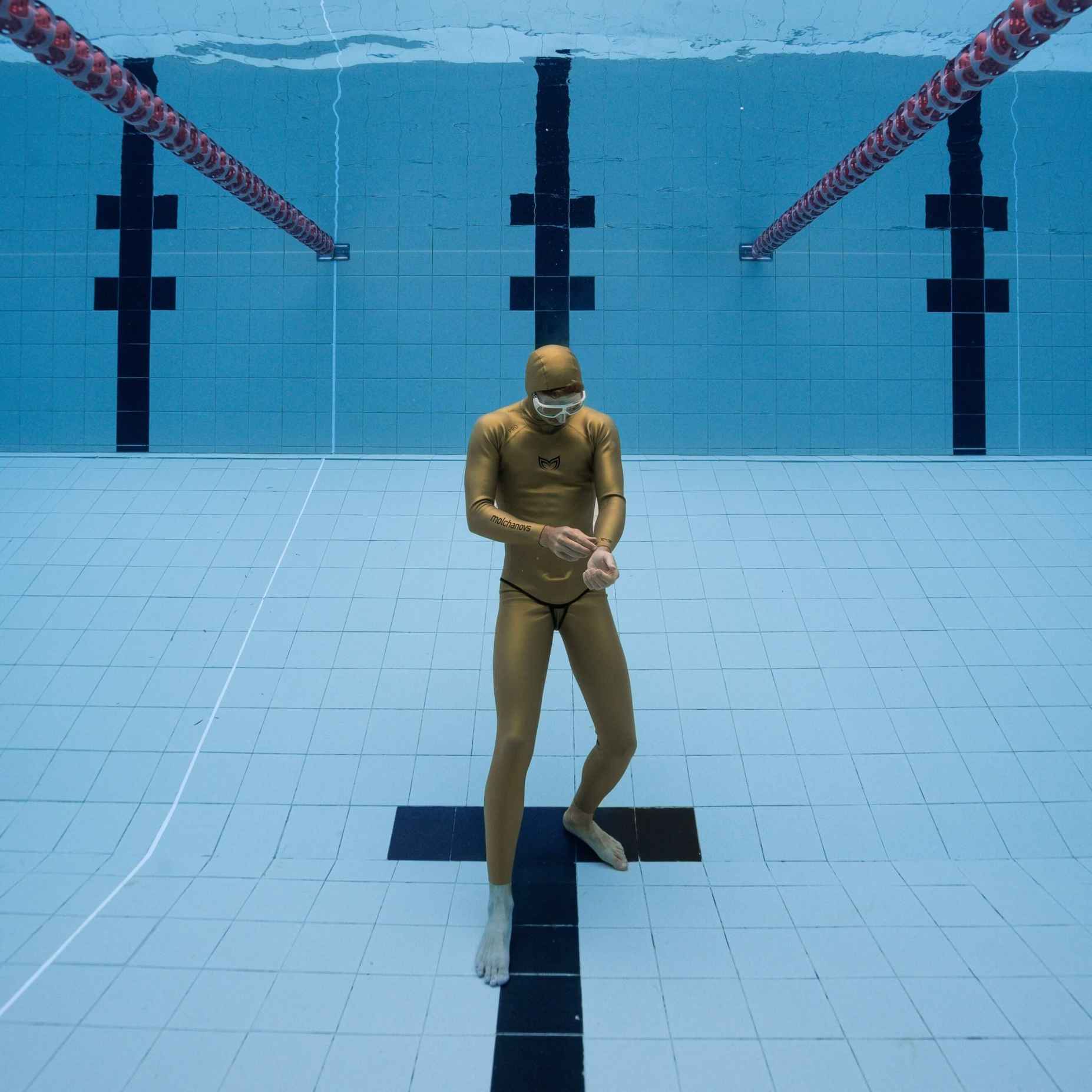How to Choose the Best Monofin for Freediving

Contributors: Alexey Molchanov & Tania Abanina

Monofins are symbolic for freedivers - they bring you speed and power and significantly reduce dive time!
Keep in mind, though, that this power comes at a great price, as quality monofins are expensive and should be customized to your unique body and individual needs.
But how do you choose the best monofin for freediving?
A monofin should be chosen based on the blade’s flexibility and the foot pocket’s comfort and fit. You should consider your physical measurements and the performance that you want out of them.
Read on to discover what specific factors you should be looking for when choosing a monofin!
Silicone monofins
To train the monofin technique efficiently, you should consider first buying a freediving-specific silicone monofin. Earlier, the silicone monofin market only included monofins specifically for speed swimmers and mermaids. Sadly, monofins for speed swimmers have too small of a surface area for freedivers, while mermaid monofins are too flexible and lack the power freedivers need.
Photo credit: @akivis
That’s why Molchanovs created the first freediving-specific monofin - the CORE Silicone Monofin! The blade is constructed entirely of silicone with a large surface area for more power. It includes a semi-rigid foot pocket connection, which makes learning the coordination and balance of the monofin technique much more effective than with bifins.
Silicone monofins can be used for training before purchasing a composite monofin, but can also be used by themselves or in addition to having a composite monofin. As you’ll read further below, monofins can be uncomfortable to train with for longer periods of time. On the other hand, silicone monofins can be worn for extended periods without the typical discomfort of performance-fit foot pockets!
Plus, freedivers who are already experienced in the monofin technique can use a silicone monofin for training and a composite monofin for longer/deeper performances.
Blade

Photo credit: @tones.of.blue
Choosing between softer and stiffer monofin blades
Faster is not necessarily better in freediving! While a monofin blade should be stiff enough for your size and weight, you need to find a compromise between effort made and oxygen consumption. If your blade is very stiff, your kicks may be more powerful and take you further - however, this comes at the cost of excess muscle activation due to more tension in the body, more oxygen burn, and more lactic acid build-up! Too soft, and you will spend too much energy excessively kicking to reach the target distance/depth. You need to find a middle ground between the two in order to achieve maximum efficiency.
It’s still preferable for a monofin blade to be slightly too soft instead of slightly too stiff - it will just require more skill to control the monofin.
Key areas of monofin blade flexibility
The blade of a monofin should be flexible and bend enough to help reduce effort during kicking. When looking over a potential monofin in person, check the flexibility of the area where the blade attaches to the foot pockets and also at the tip of the blade.
The area where the blade and foot pockets attach should have some bend, and the tip should have much more.
If the blade is too stiff where the foot pocket attaches, starting a kick will be more difficult. Having some flexibility there will reduce your effort, and a soft tip will help you create an almost effortless start!
Fiberglass or carbon monofin blade?
Composite monofin blades can be made of fiberglass or carbon fiber. While fiberglass is more durable and a top choice among competitors, carbon blades are also an option for freedivers who prefer a more lightweight blade.
This mostly boils down to preference - see if you have a friend with one or the other to try for yourself and see what you prefer!
Did you know that Molchanovs offers freedivers both the PRO Monofin 4 Fiberglass and PRO Monofin 4 Carbon?
Monofin blade size
Molchanovs gives freedivers the choice of ‘Small’ monofin blades, which have less surface area than ‘Regular’ blades. They’re ideal for shorter freedivers because of their ease of maneuverability and require less power and energy spent on kicks. Keep in mind that the reduced surface area of ‘Small’ blades results in a slightly reduced stiffness compared to ‘Regular’ blades of the same stiffness.
If you are under 65kg (143lb), shorter than 170cm (5 feet 7 inches), or have shorter legs, you should consider choosing a ‘Small’ monofin blade.
Foot pockets
Foot pockets play a critical role in monofins - they transfer the energy of a kick to the blade, after all! That’s why athletes wear fins with foot pockets 1 - 2 sizes smaller for competition than what they would normally wear - the tighter the foot pocket, the better the transfer of energy. If the foot pockets are loose or if there is space for the foot to move inside, energy transfer will suffer. Of course, this makes the foot pockets uncomfortable for longer periods of wear, so you must strike a balance between how snug the foot pockets are on your feet and how long you’re planning to wear the monofin each time you use it.
Blisters can also happen due to constant rubbing of your naked foot against rubber. However, with the right foot pocket inner lining, such as the Comfort Lining inside the Molchanovs hand-built foot pockets, this doesn’t have to be a problem!
So while foot pockets should be comfortable, freedivers use different factors to measure the ‘comfort’ of monofin foot pockets.

Photo credit: @tones.of.blue
Key foot pocket elements to consider:
- Stiffness
- Arch support
- Inner material
- Fit
Stiffness
Rigid and stiff pockets do not make kicking the monofin any easier. Foot pockets need some stiffness, but not a significant amount; they should still have some bend to them. A bit of flexibility in the foot pocket allows you to curve your feet when you start a kick, which helps to reduce effort.
Arch support
Arch support is an important part of the foot pockets - it lessens the chances of cramps and helps prevent the arches from collapsing, which decreases fatigue in the feet.
If you have flat feet, you may want to purchase a monofin with less arch support to avoid having too much pressure in the arches of your feet. However, you can also train your feet to get used to high arch support over time.
Angle

Photo credit: @tones.of.blue
Standard foot pocket angles at Molchanovs are 30° and emphasize the back kick. On the other hand, not every freediver has flexible ankles.
If you have stiffer, less flexible ankles, you should choose a 35° angle. But if you have very flexible ankles, you can choose a 25° foot pocket angle.
Remember that the angle of the foot pocket impacts your freefall at depth! If you want to stay streamlined , you must angle the fin with your ankles and knees just so to avoid any drag!
Inner material
Whether you are training depth in open water or swimming laps in a pool, you may be wearing your monofin for an extended period of time. Look for soft rubber material inside of the foot pockets to avoid torturing your feet.
Molchanovs foot pockets include Comfort Lining, a soft micropore interior to protect your feet from blisters. But if you’re worried about the lining compressing at depth, you also have the option of not including it!
Fit
Foot pocket sizing is different from regular shoe sizes!
Molchanovs hand-built foot pockets have three options to choose from: Comfortable, Normal, and Tight fit:
Comfortable: Allows more space inside of the foot pockets for your feet. Your feet will feel like they are on the verge of movement, but will not actually have movement since any friction between your feet and the foot pockets will cause blisters. Comfortable for about 2 hours of wear.
Normal: More comfortable compared to the ‘Tight’ fit. There is slightly more space inside for your feet, but not enough space for extra movement. Allows for about 20 - 50 minutes of wear.
Tight: Specifically designed for performance, which means that the fit is especially tight. This gives you the best control over the blade as the feet are very compressed with no space for any extra movement inside of the foot pocket. Suitable for about 10 - 30 minutes of wear.
Keep in mind that the maximum time you can wear foot pockets (especially ‘Tight’ fit) depends on your level of experience and how flexible your feet are. If you would like to improve your foot flexibility, watch Nataliia Zharkova’s bifin stretching routine here.
Final thoughts
There’s more than a few brands of monofins to choose from in the freediving world, but the main things you should focus on when purchasing one are the foot pockets and blades best suited to your individual needs. Choosing a customizable monofin allows you to combine all of your desired features into the perfect monofin for you!

Photo credit: @tones.of.blue
The monofin is a unique instrument, turning your dreams of flying into reality. With it, freedivers experience complete freedom of movement, gliding effortlessly beneath the surface of water, feeling as if they are a part of the ocean instead of a stranger to it. This is the true essence of freediving.
And with practice and good technique, you can experience this feeling for yourself!





Leave a comment